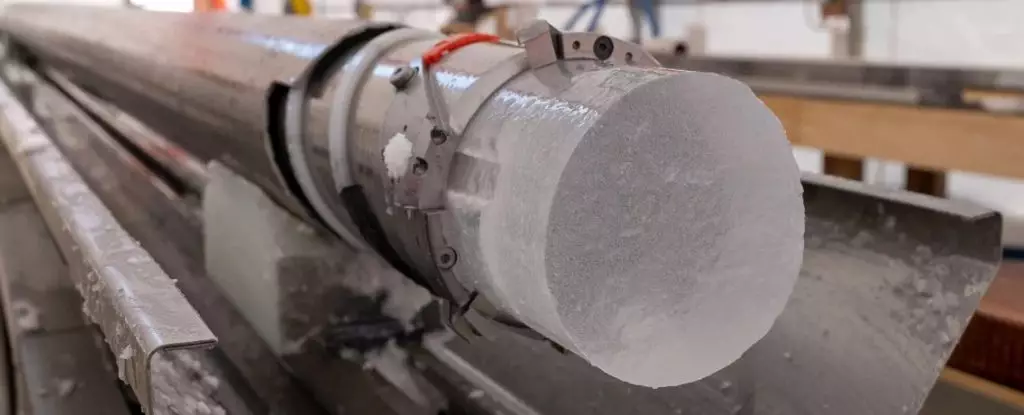The landscape of climate research has been significantly enriched by an astounding discovery from Antarctica. As scientists delve into a massive ice core sample, they may have unearthed the oldest continuous timeline of Earth’s climate, potentially extending over 1.2 million years. This monumental ice core, measuring 2,800 meters in length, offers a unique opportunity to glean insights into our planet’s climatic history, providing critical context amid the current climate crisis.
Imagine a structure long enough to stretch across iconic landmarks like San Francisco’s Golden Gate Bridge—this colossal ice core stands as a testament to our planet’s deep history. Divided into segments, the ice core layers hold up to 13,000 years of history in each meter, capturing ancient air bubbles that serve as time capsules of Earth’s atmosphere. Notably, the uppermost 2,480 meters of this sample have the potential to reveal climatic records that date as far back as 1.2 million years. This revelation establishes a solid foundation for understanding drastic shifts in climate that have occurred over millennia, which poses essential insights for contemporary climate challenges.
Julien Westhoff, leading the analysis for the European Project for Ice Coring in Antarctica (EPICA), emphasizes the groundbreaking nature of this core. While the ice cores previously extracted reached back 740,000 years, this new drilling may transcend those bounds and possibly access even older ice that could date back to the pre-Quaternary period, which exceeds 2.5 million years. However, it’s crucial to note that the oldest ice identified thus far is fragmented by geological processes, preventing a linear examination of climate history.
For climate scientists, ice cores are invaluable research tools. They encapsulate particles, isotopes, and bubbles of atmospheric gases, including carbon dioxide and methane. These materials provide key data that allow researchers to reconstruct historical climates and comprehend how Earth’s environment has transformed. The data gleaned from the latest drilling venture is particularly compelling, as it may shine light on a pivotal period between 900,000 and 1.2 million years ago—a time when Earth experienced pronounced variations in glaciation cycles.
Emerging theories suggest that these extremes may have had a catastrophic impact on early human populations in Africa, with claims that close to 99 percent might have perished during this volatile epoch. It’s essential to approach these claims with a critical mindset, as they often rely on modern genetic interpretations, necessitating further investigation.
The insights derived from the Antarctic ice core are expected to provide the foundational benchmarks needed to understand the current trajectory of climate change. As anthropogenic emissions lead to unprecedented alterations in our climatic patterns, the revelations from these ancient layers will likely illustrate the stark contrasts between natural and human-induced cycles of glaciation. Carlo Barbante, director of EPICA, captures this sentiment by accentuating the ongoing scientific conundrum surrounding greenhouse gas interactions and ice sheet dynamics.
Moreover, the data from this ice core serves to affirm how dramatically human activity has veered from Earth’s natural climate pathways—since our current emissions are expected to unravel climatic balance that has been established over hundreds of thousands of years.
The ice core drilling was conducted at Little Dome C, strategically positioned in East Antarctica due to its thick layers of ice. Rising to 3,200 meters above sea level, this high-altitude site presents harsh conditions, with summer temperatures often plummeting to around -35°C (-31°F). Despite these adversities, scientists endeavored to transport their research infrastructure from a nearby station, a process that alone required approximately 20 days.
During the extraction phase, an innovative real-time isotopic analysis was integrated into drilling processes, allowing researchers to monitor glacial and interglacial cycles as they surfaced from deep within the ice. This capacity for immediate analysis underscores the excitement surrounding preliminary findings, culminating in lofty anticipations for future revelations.
As we stand on the precipice of groundbreaking research facilitated by the EPICA initiative, the potential knowledge to be harvested from this ice core is immense. It poses questions about both our past and future climatic conditions, enabling us to map the intricate relationship between greenhouse gases and temperature fluctuations over extended timeframes.
Richard Alley, a respected climate scientist not associated with the EPICA project, shares in the optimism, predicting a wealth of discoveries to emerge from this remarkable data. Indeed, as scientists delve deeper into this frozen archive, we may uncover not only truths about our historical climate patterns but also crucial lessons that could steer our response to our present-day environmental crises.
The remarkable findings from Antarctica’s ice core have the potential to redefine our understanding of climate history, reveal critical insights about prehistoric civilizations, and pave the way for proactive measures in combating accelerating climate change.


Leave a Reply